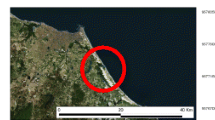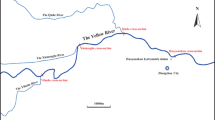Abstract
Ecotoxicological effects associated with contaminants present in dredged material from three Spanish ports, Ría of Huelva (SW, Spain), La Coruña (NW, Spain) and Bay of Cádiz (SW, Spain) were determined using a marine biotest based on endocrine disruption effects (vitellogenesis process alteration). Intermoult female Carcinus maenas were exposed in the laboratory to sediments from the Spanish ports per replicate during 21 days. Crab haemolymph samples were taken for vitellogenin/vitellin (VTG) analysis on days 0, 7, 14 and 21. Furthermore, chemical analysis was performed in the stations to determine the degree and nature of sediment contamination (Cr, Ni, Cu, Zn, Cd, Pb, Hg, As, PAHs and PCBs). A significant induction (P < 0.05) in vitellogenin/vitellin concentration was observed over time in individuals exposed to sediment samples containing significant concentrations of PAHs, PCBs, Hg, Pb and Zn. The toxicokinetic approach, proposed in this study related to the use of this biomarker in C. maenas, proved to be a powerful and sensitive tool to evaluate toxicity effects associated with contaminants present in dredged material. Moreover the integration of the results obtained through multivariate analysis approach (MAA) allowed the identification contaminants bound to sediments associated with adverse effects, validating the use of this marine biotest in a regulatory framework.



Similar content being viewed by others
References
Blaise C, Gagnè F, Pellerin J, Hansen PD (1999) Determination of vitellogenin-like properties in Mya arenaria hemolymph (Saguenay Fjord, Canada): a potential biomarker for endocrine disruption. Environ Toxicol 14:455–465
Blaise C, Gagnè F, Salazar M, Salazar S, Trottier S, Hansen PD (2003) Experimentally-induced feminisation of freshwater mussels after long-term exposure to a municipal effluent. Fresenius Environ Bull 12:865–870
Bouskill NJ, Handy RD, Ford TE, Galloway TS (2006) Differentiating copper and arsenic toxicity using biochemical biomarkers in Asellus aquaticus and Dreissena polymorpha. Ecotoxicol Environ Saf 65: 342–349
CEDEX (Centro de Estudios y Experimentación de Obras Públicas) (1994) Recomendaciones para la gestión del material de dragado en los puertos Españoles. Puertos del Estado, Madrid
Charniaux-Cotton H, Payen G (1988) Crustacean reproduction. In: Laufer H, Downer GH (eds), Endocrinology of selected invertebrate types. Alan R.Liss, New York, pp 279–303
Comreys AL (1973) A first course in factor analysis. Academic Press, New York
Depledge MH, Billinghurst Z (2003) Ecological significance of endocrine disruption in marine invertebrates. Mar Pollut Bull 39:32–38
DelValls TA, Chapman PM (1998) Site-specific sediment quality values for the Gulf of Cádiz (Spain) and San Francisco Bay (USA), using the sediment quality triad and multivariate analysis. Cienc Mar 24:3313–3336
Frane J, Jenrich R, Sampson P (1985) Factor Analysis. In: Dixon WJ (ed) BMDP statistical software. University of California Press, Berkeley, pp 480–500
Gagnè F, Blaise C, Pellerin J, Gauthier-Clerc S (2002) Alteration of the biochemical properties of female gonads and vitellins in the clam Mya arenaria at contaminated sites in the Saguenay Fjord. Mar Environ Res 53:295–310
Hutchinson TH, Pickford DB (2002) Ecological risk assessment and testing for endocrine disruption in the aquatic environment. Toxicology 181–182:383–387
Kime DE, Nash JP, Scott AP (1999) Vitellogenesis as a biomarker of reproductive disruption by xenobiotics. Aquaculture 177:345–352
Lee RF, Walker A (1995) Lipovitellin and lipid droplet accumulation in oocytes during ovarian maturation in the blue crab, Callinectes sapidus. J Exp Zool 271:401–412
Marín MG, Matozzo V (2004) Vitellogenin induction as a biomarker of exposure to estrogenic compounds in aquatic environments. Mar Pollut Bull 48:835–839
Martín-Díaz ML, Blasco J, Sales D, DelValls TA (2004a) Biomarkers as tools to assess sediment quality. Laboratory and field surveys. TrAC Trends Analyt Chem 23(10–11):807–818
Martín-Díaz ML, Bamber S, Casado-Martínez MC, Sales D, DelValls TA (2004b) Toxicokinetic of heavy metals from a mining spill using Carcinus maenas. Mar Environ Res 58:833–837
Martín-Díaz ML, Villena-Lincoln A, Bamber S, Blasco J, DelValls TA (2005) An integrated approach using bioaccumulation and biomarker measurements in female shore crab Carcinus maenas. Chemosphere 58:615–626
Martín-Díaz ML, Tuberty SR, McKenney Jr CL, Blasco J, Sarasquete C, DelValls TA (2007) The use of bioaccumulation, biomarkers, histopathology diseases in Procambarus clarkii to establish bioavailability of Cd and Zn after a mining spill. Environ Monit Assess 116:169–184
Martín-Díaz ML, Jiménez-Tenorio N, Sales D, DelValls TA (2008) Accumulation, histopathological damage in the clam Ruditapes philippinarum and the crab Carcinus maenas to assess sediment toxicity in Spanish ports. Chemosphere (in press)
Naqvi SM, Howell RD (1993) Toxicity of cadmium and lead to juvenile red swamp crayfish, Procambarus clarkii, and effects on fecundity of adults. Bull Environ Contam Toxicol 51:303–308
Nendza M (2002) Inventory of marine biotest methods for the evaluation of dredged material and sediments. Chemosphere 48:865–883
Oberdörster E, Cheek AO (2001) Gender benders at the beach: endocrine disruption in marine and estuarine organisms. Environ Toxicol Chem 20(1):23–36
Pateraki LE, Stratakis E (1997) Characterization of vitellogenin and vitellin from land crab Potamon potamios: identification of a precursor polypeptide in the molecule. J Exp Zool 279:597–608
PIANC Generic biological assessment guidelines for dredged material. Port International Association for Navigation and Commerce. Technical report work-group 8-environmental contamination (in press)
Riba I, DelValls TA, Forja JM, Gómez-Parra A (2002) Influence of the Aznalcóllar mining spill on the vertical distribution of heavy metals in sediments from the Guadalquivir estuary (SW, Spain). Mar Pollut Bull 44:39–47
Rodríguez EM, Medesani DA, Fingerman M (2006) Endocrine disruption in crustaceans due to pollutants: a review. Comp Biochem Physiol Part A 146:661–671
Rodríguez-Obeso O, Alvarez-Guerra M, Andrés A, Viguri JR, DelValls TA, Riba I Martín-Díaz ML (2007) Monitoring and managing sediment quality and impact assessment in Spain in the past 10 years. TrAC Trends Analyt Chem 26(3):252–260
Tuberty SR (1998) Vitellogenesis in the red swamp crayfish, Procambarus clarkii. Dissertation. Tulane University, New Orleans, Louisiana, pp 151
Van der Oost R, Beyer J, Vermeulen NPE (2003) Fish bioaccumulation and biomarkers in environmental risk assessment. Environ Toxicol Pharmacol 13:57–149
Acknowledgements
This research was supported by a grant from the Convenio PICOVER (Consejería de Medio Ambiente, Junta de Andalucía, Spain) and by grant REN2002–01699 from the Spanish National Plan for research, innovation and development (Ministerio de Ciencia y Tecnología). English in the manuscript has been edited by Tom Ransome.
Author information
Authors and Affiliations
Corresponding author
Rights and permissions
About this article
Cite this article
Martín-Díaz, M.L., Sales, D. & DelValls, Á. Toxicokinetic approach for the assessment of endocrine disruption effects of contaminated dredged material using female Carcinus maenas . Ecotoxicology 17, 495–503 (2008). https://doi.org/10.1007/s10646-008-0203-3
Received:
Accepted:
Published:
Issue Date:
DOI: https://doi.org/10.1007/s10646-008-0203-3




